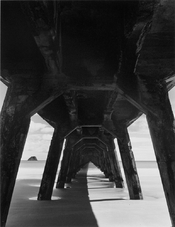Vaughn
Subscriber
I made a solo 5-month 2000-mile photo tour through New Zealand by bicycle almost 4 decades ago. I had a 4x5, five film holders, a changing bag, and BW film (Royal Pan and SuperXX). I went to see/explore the light, record that light, and make a portfolio of my experience with that light -- and the landscape that reflected it. .
I ended up exposing 72 sheets of film in 6 month and printing a 20 print portfolio (16x20 silver gelatin) -- which, thru the years with experience and critical thought, could easily be whittled down to a 12 print solid portfolio. Perhaps even some re-printing and exploration of unprinted negatives would be beneficial -- but I have not silver printed since '92 and feel no need to. I'll let them be.
But I consider the trip very productive, volume-wise. Using film and my time on 'maybes' would mean missing out on some of the "probables". It is a decision one makes when one only has one or two unexposed holders of film left for the next few days. Many times I tore the camera down without exposing because what I saw on the GG was a maybe.
I run into the same situation now -- backpacking for 4 or 5 days with a 4x5 or 5x7 means a limitation of holders and film. Up to 9 loaded 4x5 holders, or 5 to 6 5x7 holders with no reloading. Encourages pre-editing! But that is how I approach, for better or worse. Perhaps it is due to my introduction to photography with a Rolleiflex -- those 12 shots go fast!
Whatever makes one productive.
I ended up exposing 72 sheets of film in 6 month and printing a 20 print portfolio (16x20 silver gelatin) -- which, thru the years with experience and critical thought, could easily be whittled down to a 12 print solid portfolio. Perhaps even some re-printing and exploration of unprinted negatives would be beneficial -- but I have not silver printed since '92 and feel no need to. I'll let them be.
But I consider the trip very productive, volume-wise. Using film and my time on 'maybes' would mean missing out on some of the "probables". It is a decision one makes when one only has one or two unexposed holders of film left for the next few days. Many times I tore the camera down without exposing because what I saw on the GG was a maybe.
I run into the same situation now -- backpacking for 4 or 5 days with a 4x5 or 5x7 means a limitation of holders and film. Up to 9 loaded 4x5 holders, or 5 to 6 5x7 holders with no reloading. Encourages pre-editing! But that is how I approach, for better or worse. Perhaps it is due to my introduction to photography with a Rolleiflex -- those 12 shots go fast!
Whatever makes one productive.






 Don't know if I would enjoy it as much now!
Don't know if I would enjoy it as much now!

